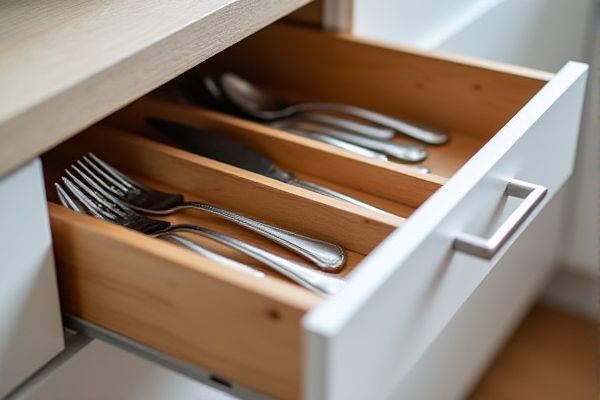
Choosing between a flatware drawer and a cutlery tray depends on your kitchen organization needs, as flatware drawers offer a sleek, integrated storage solution while cutlery trays provide customizable compartments for easy access. Explore the rest of the article to discover which option best suits your cooking habits and kitchen space.
Table of Comparison
| Feature | Flatware Drawer | Cutlery Tray |
|---|---|---|
| Design | Built-in drawer for organized flatware storage | Removable tray that fits inside drawers |
| Capacity | Higher capacity, fits multiple sets of flatware | Limited capacity, suitable for basic cutlery |
| Accessibility | Easy access with dedicated compartments | Simple, but may require tray removal for deeper items |
| Installation | Requires built-in installation during kitchen design | No installation needed, easy to add or remove |
| Customization | Custom compartments for different flatware types | Standard compartments, less customizable |
| Material | Varies: wood, metal, or plastic | Commonly plastic or metal |
| Cost | Generally higher due to built-in feature | Affordable and budget-friendly |
| Maintenance | Requires regular cleaning but durable | Easy to clean and washable |
Flatware Drawer vs Cutlery Tray: An Overview
A flatware drawer offers a built-in organizational solution designed to maximize kitchen space by neatly separating utensils within custom compartments. A cutlery tray is a portable insert that fits inside standard drawers, providing flexible and affordable storage for flatware but often limiting the quantity it can hold. Choosing between a flatware drawer and a cutlery tray depends on your kitchen layout and storage needs to ensure your utensils remain accessible and well-organized.
Key Differences Between Flatware Drawers and Cutlery Trays
Flatware drawers are built-in compartments designed to organize flatware neatly within kitchen cabinets, offering customized slots for utensils and maximizing drawer space. Cutlery trays are removable inserts that fit inside existing drawers, providing flexible organization and easy access to everyday utensils. Choosing between the two depends on your kitchen layout, convenience preferences, and the level of organization you require for your cutlery collection.
Material Choices: Durability and Aesthetics
Flatware drawers often feature solid wood or metal materials that offer superior durability and a premium aesthetic, making them ideal for long-term use and sophisticated kitchen designs. Cutlery trays are typically made of plastic, bamboo, or silicone, balancing affordability with lightweight convenience while providing decent resistance to daily wear. Choosing between the two depends on the desired blend of robustness, visual appeal, and maintenance needs in kitchen organization solutions.
Space Efficiency and Storage Capacity
Flatware drawers maximize space efficiency by utilizing deep compartments that accommodate a larger variety of utensils, optimizing vertical storage potential. Cutlery trays, while offering segmented organization, often provide limited storage capacity due to their shallow design and fixed sections. Choosing flatware drawers enhances overall kitchen storage by leveraging drawer depth and flexible compartment arrangements, making them ideal for households with extensive utensil collections.
Organization and Accessibility
A flatware drawer offers a customizable layout that maximizes organization by allowing separation of forks, knives, spoons, and other utensils into designated compartments. This design enhances accessibility by providing a clear overview and easy retrieval, reducing clutter compared to traditional cutlery trays. Cutlery trays, while commonly used, often limit flexibility in arrangement and can lead to mixed utensil storage, making flatware drawers a superior choice for streamlined kitchen organization.
Cleaning and Maintenance Requirements
Flatware drawers typically require less frequent cleaning since utensils are stored in a single compartment, reducing the chances of food residue buildup compared to cutlery trays. Cutlery trays need regular washing and drying to prevent bacteria growth in the multiple sections where food particles can accumulate. Materials like stainless steel flatware drawers offer easier maintenance and durability over plastic cutlery trays, which can stain or crack over time.
Installation and Setup Considerations
Flatware drawers require precise measurements and often professional installation to ensure smooth sliding mechanisms fit seamlessly into your cabinetry, maximizing storage efficiency. Cutlery trays offer a simpler setup, typically requiring only placement inside existing drawers without modifications, making them ideal for easy customization and immediate use. Your choice depends on whether you prioritize a streamlined, built-in look or a flexible, ready-to-use solution for organizing utensils.
Best Uses for Flatware Drawer Solutions
Flatware drawer solutions are ideal for organizing utensils in kitchen drawers, maximizing space with compartments tailored to sizes and types of cutlery. These systems keep forks, knives, spoons, and specialty tools neatly separated, enhancing accessibility and reducing clutter. They are best used in kitchens with deep drawers or where a sleek, minimalist countertop is preferred over traditional cutlery trays.
Advantages of Using a Cutlery Tray
A cutlery tray maximizes drawer organization by providing individual compartments tailored for different utensils, preventing clutter and easy access. Your kitchen efficiency improves as the tray keeps forks, knives, and spoons neatly separated, reducing time spent searching during meal preparation. This streamlined arrangement also protects flatware from scratches, ensuring your cutlery remains in pristine condition.
Which One Should You Choose for Your Kitchen?
Choosing between a flatware drawer and a cutlery tray depends on your kitchen layout and organization preferences. A flatware drawer offers more custom compartments and can accommodate larger utensils, making it ideal for those seeking streamlined storage and easy access. A cutlery tray fits standard drawers and provides basic separation, suitable for smaller kitchens or renters wanting a simple, portable solution.
 homyna.com
homyna.com